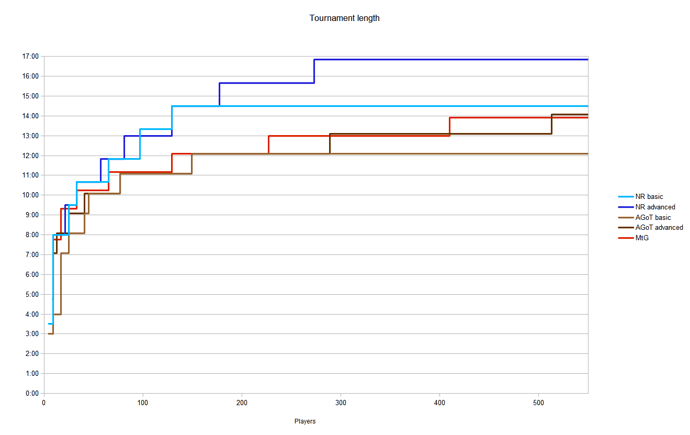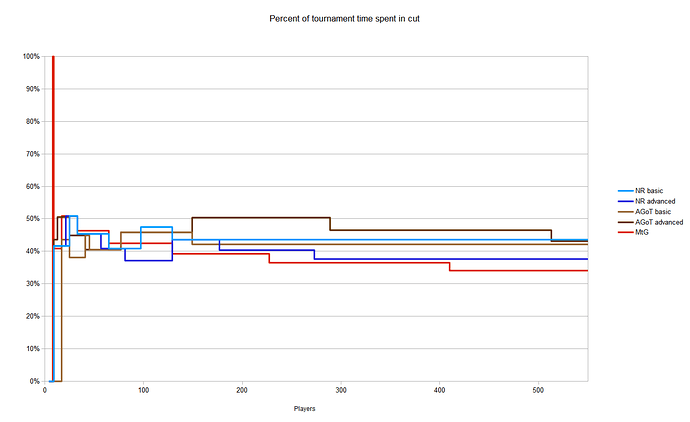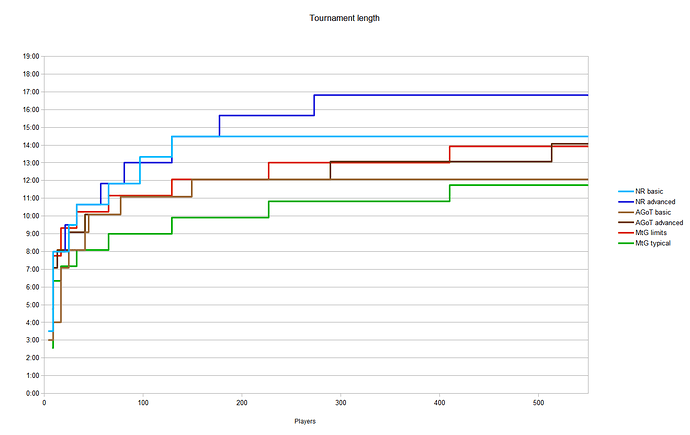TL;DR: How should the number of rounds in a tournament be chosen?
In the Excalibur tournament software thread, 5N00P1 suggested that Excalibur should include some guidance for tournament length:
My initial thought was that tournaments should be long enough to determine a winner conclusively and short enough to fit in the available time, and that within those two limits, more rounds is probably better, because more Netrunner is good. So long as there’s a lunch break, anyways.
So if I were to write guidance for how many rounds tournaments should have, it would probably take into account both the player count and the available time. And if it were intended to accompany Excalibur, it would probably recommend either single game or two game rounds based on that.
For instance, if you have four hours and four players, a round robin of two-game rounds makes sense; if you have the same time and six players, a round robin of one-game rounds might be better than three two-game rounds of Swiss; with twenty players, five one-game rounds of Swiss is likely the best choice. But if you have eight hours and six players, then the best option would probably be a round robin of two-game rounds.
I calculated the time needed for the tournament structures from the tournament regulations, since I figured that tournament length advice should take into account the official recommendations. I assumed that all rounds take five minutes longer than the allotted time. That’s probably too short for a big tournament, but in small tournaments rounds sometimes don’t even go to time, so I figure five minutes is probably a good middle ground.
Official tournament structures lengths
###Basic structure
Players Swiss rounds Cut size Swiss time Cut time Total time
4-8 3 3:30 3:30
9-24 4 4 4:40 3:20 8:00
25-32 4 8 4:40 4:50 9:30
33-64 5 8 5:50 4:50 10:40
65-96 6 8 7:00 4:50 11:50
96-128 6 16 7:00 6:20 13:20
129+ 7 16 8:10 6:20 14:30
###Advanced structure
Players Swiss rounds Cut size Swiss time Cut time Total time
9-20 4 4 4:40 3:20 8:00
21-32 4 8 4:40 4:50 9:30
33-56 5 8 5:50 4:50 10:40
56-80 6 8 7:00 4:50 11:50
81-128 7 8 8:10 4:50 13:00
129-176 7 16 8:10 6:20 14:30
177-272 8 16 9:20 6:20 15:40
273+ 9 16 10:30 6:20 16:50
(The spreadsheet is here if you want to check my math or make a copy and try different assumptions)
Looking at that data, I think many tournaments should probably have smaller cuts than the official basic structure. With 25-32 players, the cut takes longer than the Swiss. That may be fine for more competetive tournaments, but to me that seems counter to the goal of being “very accessible, especially for newer participants.” And it makes the overall tournament very long - a twenty-five player tournament under the basic structure is nine and a half hours, not including any breaks, which seems awfully long for a one day less-competitive tournament. But having a two-day tournament for a twenty-five player store championship seems silly.







